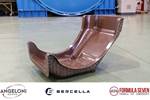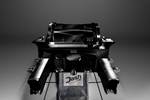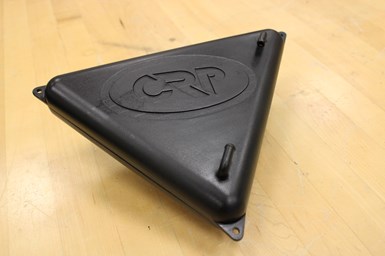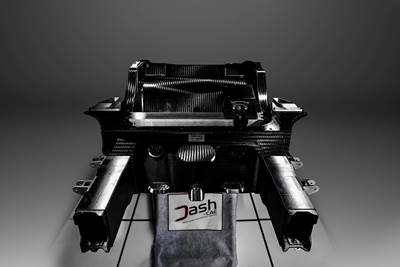CRP 3D printing composites optimize Formula SAE team’s racing performance
Long-term CRP USA and UVic Formula Racing partnership has culminated in the development of versatile, durable carbon fiber-filled components that continue deliver on the track.
Over the years, the partnership between CRP USA (Mooresville, N.C., U.S.) and the University of Victoria’s UVic Formula Racing (British Columbia, Canada) team has culminated in the creation of several highly functional composite parts using CRP’s carbon fiber-filled Windform materials and the laser sintering process. These components are distinguished by their versatility, mechanical properties and durability. One of UVic’s latest examples include the steering wheel and elements of the engine lubrication system, which have become integral parts of the car.
“Like every year, the industry judges at the competition were very interested in the parts that CRP USA 3D printed for our racing car,” Luke Wooldridge, powertrain lead of UVic Formula Racing from University of Victoria, says.
One innovation was the team’s newly designed oil and water catch cans, which integrated better with the chassis packaging. These components were made from Windform SP, a carbon fiber-filled composite material from CRP’s Windform 3D printing range. Windform SP held up especially well to the high heat of the overflowing oil and coolant. “No significant damage was noted to either modules with water coolant temperature reaching ~125ºC and the oil reaching ~150ºC,” Wooldridge notes.
This year, the team also had a new faceplate made for their steering wheel, for use with improved driver control switches. The part was made using Windform XT 2.0, another carbon fiber-filled composite solution with hand grips manufactured from Windform RL, a thermoplastic elastomer. According to Wooldridge, the materials provide a better finished part, since none of the in-house prints the university team made could provide the resistance to heat, impact and direct sunlight needed from it. As a result, the steering wheel has become a centerpiece of the team’s car.
Within the car’s powertrain system, CRP USA has helped the UVic team develop a number of iterations of their oil pan over the last few years, each made from Windform SP due to its impact resistance and resistance to high temperatures. “The flexibility in the manufacturing process has allowed us to design a reduction in the overall height of the oil pan and incorporate anti-sloshing features such as one-way baffle doors directly into the print,” Wooldridge states.
Reducing the overall height enabled the team to drop the engine’s position in the chassis, lowering the weight distribution of the car and improving on-track, dynamic performance. In addition, CRP USA also 3D-printed a custom oil pick-up to go with the oil pan design, once again made from Windform SP.
Moreover, UVic Formula Racing’s aerodynamics system uses front wing inserts printed in Windform XT 2.0. These inserts act as a transition from the central wing element to the two outer ones while also providing the attachment points for the front wing onto the chassis.
The intake, manufacturd through CRP USA out of Windform XT 2.0 back in 2019, has held up well, lasting the team four seasons. “During our competition, we had engine block temperatures reaching up to 125ºC and we experienced no warping or deformation at the mating surface between the cylinder head and intake,” Wooldridge explains. “This thermal stability is critical to the reliability of our car as any deformation at this surface could lead to a catastrophic intake leak which would put us out of the race.”
Nevertheless, the UVic Formula Racing team recently redesigned the intake to be larger and have a more optimized geometry for airflow into the engine. This new intake was made again from Windform XT 2.0 composites.
Discussing some of the engineering characteristics of the new intake design, Wooldridge says, “Thanks to the manufacturing capabilities of CRP USA, we were able increase the overall size drastically, from a volume of 1.41 liters to 4.24 liters, while still having the print resolution necessary to print sealing surfaces and sensor mounting directly into our intake without the need for post-machining. The larger intake allowed us to transition from bent to straight intake runners improving the simulated efficiency of our air flow by 100%.” The team plans to have the new intake up and running in the next few weeks.
Ultimately, “the durability of all the components 3D-printed by CRP USA is incredible,” Wooldridge emphasizes. “In all honesty, we ask a lot of these parts when we are out on the track, and they continue to deliver. For example, this year, during testing, we struck a traffic cone hard enough to shear off the screw attaching the front wing to the chassis and bend our aluminum mounting arm without damaging the wing insert in Windform XT 2.0 attached to the other side.”
Read’s CW’s applications piece for more information, “3D printing, composite materials enable motorsports design flexibility.”
Related Content
McLaren celebrates 10 years of the McLaren P1 hybrid hypercar
Lightweight carbon fiber construction, Formula 1-inspired aerodynamics and high-performance hybrid powertrain technologies hallmark this hybrid vehicle, serve as a springboard for new race cars.
Read MoreTU Munich develops cuboidal conformable tanks using carbon fiber composites for increased hydrogen storage
Flat tank enabling standard platform for BEV and FCEV uses thermoplastic and thermoset composites, overwrapped skeleton design in pursuit of 25% more H2 storage.
Read MorePEEK vs. PEKK vs. PAEK and continuous compression molding
Suppliers of thermoplastics and carbon fiber chime in regarding PEEK vs. PEKK, and now PAEK, as well as in-situ consolidation — the supply chain for thermoplastic tape composites continues to evolve.
Read MoreThe lessons behind OceanGate
Carbon fiber composites faced much criticism in the wake of the OceanGate submersible accident. CW’s publisher Jeff Sloan explains that it’s not that simple.
Read MoreRead Next
Bercella, Formula Seven target motorsport innovation with natural fiber composite developments
AmpliTex flax fiber used to develop Formula SAE single-seater racing seat for better resistance, vibration absorption and reduced environmental impact.
Read MoreESA approves Windform RS, LX 3.0 for space flight applications
CRP Technology’s Top-Line composite materials Windform RS and Windform LX 3.0 are compliant with outgassing requirements in accordance with ESA-TEC-PR-002015.
Read MoreDash-CAE launches low-cost carbon fiber monocoque for road cars
The Formula 1 supplier delivers the TR01, an affordable, versatile and lightweight composite chassis that opens new possibilities for hypercar, supercar and motorsport projects.
Read More














.jpg;maxWidth=300;quality=90)










